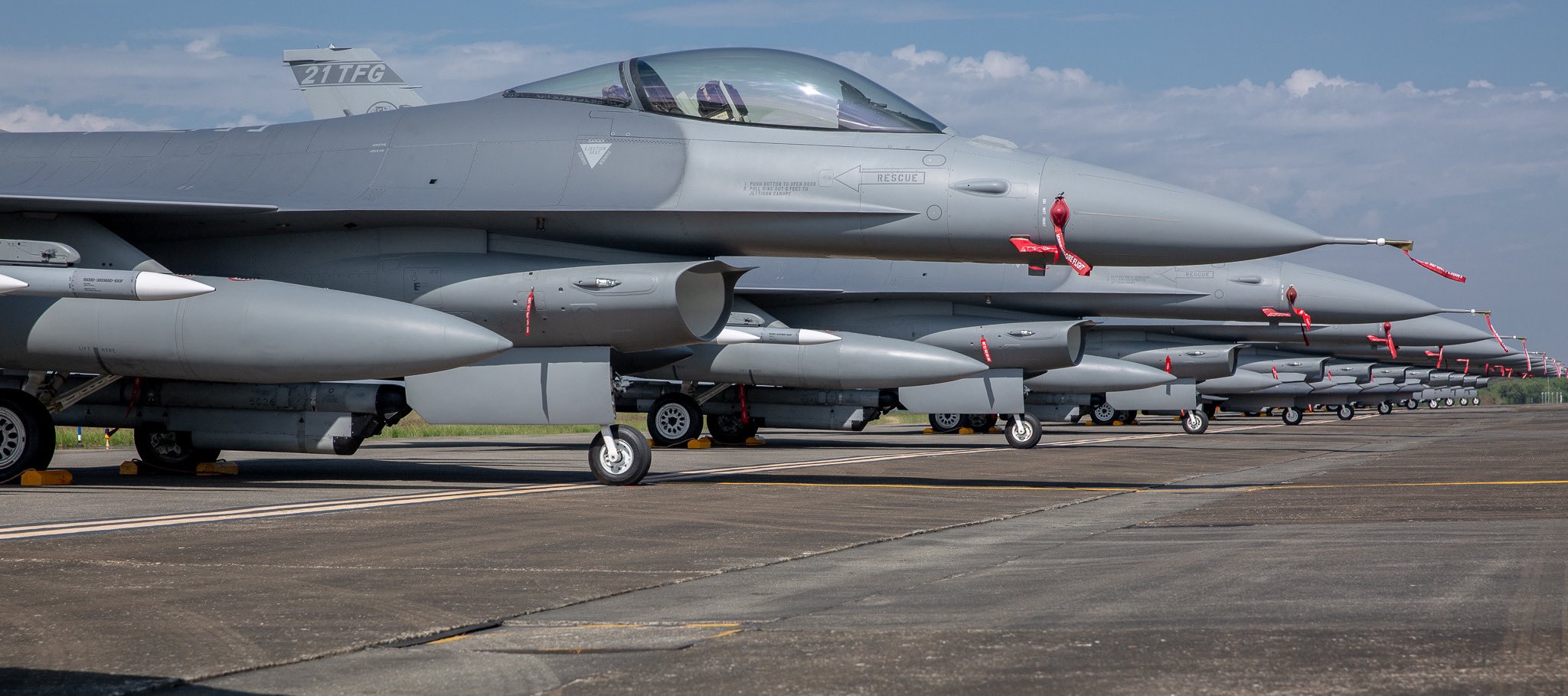Taiwan has reportedly received the first of 66 F-16 Viper fighter jets ordered from Lockheed Martin. Once inducted, the US-origin aircraft will be Taiwan’s best bet against the advanced fifth-generation Chinese fighter jets.
Taiwan has not officially announced receiving the F-16 Block 70 Viper at the time of writing this report. However, US Congressman William Timmons posted photographs on X from what he described as the “F-16 Taiwan Delivery Ceremony” that took place at manufacturer Lockheed Martin’s Greenville facility in South Carolina.
Deputy Minister of National Defense Po Horng-hui and Representative to the US, Alexander Yui, also reportedly attended the ceremony.
Additionally, Joseph Wu, the Secretary-General of Taiwan’s National Security Council, posted a photo of himself standing in front of an F-16 with the caption: “We’ll soon have 66 new F-16 Vipers (block70) to protect our sky.”
According to local media, the first batch of these fighter jets will be delivered to the 7th Tactical Fighter Wing, a newly established air force unit for the defense of Taiwan proper’s eastern region. The Republic of China Air Force (RoCAF) fighter pilots have reportedly been sent to the United States to train on the F-16 Viper.

Although much behind the original schedule, the delivery is significant amid the rising security threat from China. Beijing considers the self-ruled island state of over 23 million people a renegade province and has vowed to unite with the mainland.
Beijing has increased its military activity (including drills simulating encirclement of the Taiwanese island) in the Taiwan Strait and recently launched barges that could be used to deliver tanks and armored vehicles in the event of an invasion.
Taiwan’s acquisition of the F-16V is part of a larger military modernization effort launched by successive pro-democracy governments to thwart a potential Chinese invasion.
In addition to buying 66 fighters from Lockheed Martin, Taiwan is upgrading 139 of its F-16s to the Viper variant and acquiring new F-16Vs under the “Peace Phoenix Rising” initiative.
According to local Taiwanese reports, the first fighter jet will be inducted into service in the RoCAF later this year, and the delivery of all 66 F-16 Vipers is expected to conclude by the end of 2026.
Upon its induction, the F-16V would be Taiwan’s most advanced aerial combat asset and the cornerstone of its air force.
The F-16 Viper Vs. China’s J-20
Despite being the most advanced aircraft in Taiwan’s inventory, the 4++ generation F-16 Block 70 would be pitted against the Chinese fifth-generation stealth fighters and possibly even sixth-generation fighters, albeit at a later stage.
Despite being a 4++ generation fighter, the enhanced F-16V presents many advanced features courtesy of its upgraded avionics suite. The aircraft features the Northrop Grumman AN/APG-83 Scalable Agile Beam Radar (SABR) with its active electronically scanned array (AESA). The cutting-edge radar technology increases resilience to electronic countermeasures, improves target-spotting capabilities for low-signature objects like cruise missiles, and extends detection and engagement ranges.
The F-16V’s upgraded center pedestal display enhances tactical situational awareness by giving the pilot access to data gathered by the SABR and other sensors.
The upgrades include a sniper aiming pod, Link 16, a cueing system installed on the helmet, precise GPS navigation, enhanced weapon capability, an upgraded modular mission computer, and an ethernet high-speed data network.
The aircraft’s wings, fuselage, and landing gear have also received several structural upgrades that have improved their functionality and sustainability. Additionally, it allows for a higher takeoff and landing weight than its predecessor, the F-16 A/B variant.

Most importantly, Taiwan would be able to operate the aircraft for longer, with little hindrances, because the newly constructed F-16Vs will have a 12,000-hour service life, in contrast to the 8,000-hour service life of previous F-16s.
The upgraded F-16V fleet also boasts increased versatility in its armament, with provisions for heavy weapon payloads. These weapons include the AGM-84 Harpoon missile, which is well-known for its capability in anti-shipping roles, as well as more advanced weapons like the AGM-154 Joint Stand-Off Weapon (JSOW) for precision strikes and the AGM-88 High-Speed Anti-Radiation (HARM) missile for defense suppression.
Taiwan is also reportedly buying the JASSM for its F-16V. The missile is highly precise, durable, and more resistant to electronic warfare, including GPS jamming.
Meanwhile, China has already produced more than 200 J-20 Mighty Dragon fifth-generation stealth fighters and deployed them to all five People’s Liberation Army (PLA) theatre commands.
This essentially means that for every F-16V Taiwan will induct, the PLAAF already operates a much more advanced J-20 stealth fighter.
In November 2024, Beijing also unveiled its second fifth-generation stealth fighter, the J-35A. Earlier, the state-run Global Times reported that the PLAAF’s “announcement of the J-35A can be interpreted as confirmation of its entry into service.”
If this was not a big enough nightmare for Taiwan, China has already started working on a sixth-generation combat aircraft. Two prototypes—the J-36 and J-50 (both named by PLA watchers)—have made their first flights. The J-36 has now conducted multiple flights, with footage of nearly every test flight circulating on social media.
As per reports, China could manufacture and field the sixth-gen aircraft by the mid-2030s.
The stealth capabilities of PLAAF’s J-20 and J-35 could make it difficult for the Taiwanese F-16V to detect and engage, potentially giving the Chinese fighters an upper hand in aerial combat. For instance, a J-20 armed with ‘concealed’ PL-15 missiles could engage F-16s before Taiwanese pilots could detect it.
To counter the stealth threat, the US approved the sale of infrared search and tracking systems (IRSTs) to Taiwan in August 2023, which would allow Taiwanese F-16s to detect J-20s relatively early.

IRST uses heat signals that radiate from its target to detect it, as opposed to radar, which uses radio wave reflection to detect targets. Stealth aircraft have low radar observability, but the infrared radiation of stealth aircraft can only be decreased and not completely removed.
Meanwhile, Chinese experts contend that the People’s Liberation Army Air Force’s (PLAAF) J-20 will triumph in aerial combat despite Taiwan’s F-16 upgrades, possibly neutralizing improved Taiwanese F-16s before they even take to the skies. The experts believe that PLAAF’s KJ-500 early warning aircraft, J-20 fighters, and the aircraft’s beyond-line-of-sight missiles would render Taiwan’s F-16Vs and its IRST technology useless.
Chinese experts believe that J-20s could outperform the F-16 in beyond-visual-range combat. The J-20’s combination of stealth, radar capabilities, and long-range missiles could provide a significant advantage.
Besides the stealthy fighters, China has more than 1,500 combat jets (the number is only growing) in its inventory. In contrast, Taiwan possesses nearly 400 aircraft, including outdated F-5 and Mirage 2000 jets, locally produced F-CK-1 aircraft, and the F-16 aircraft.
Earlier, a J-20 fighter pilot told state media that he flew over the Taiwanese islands without being detected by the island’s air defenses or intercepted by its F-16 fighter jets. EurAsian Times cannot confirm the Chinese claims.
5-6 Nations Could Go Nuclear As Trump Dithers On Security Promises Raising Concerns In Europe & Asia
Meanwhile, Taiwan’s Deputy Defense Minister, Po Horng-hue, boldly asserted in March 2024, stating that Taiwan holds “absolute air superiority” over China in its airspace. Po, a retired pilot himself, highlighted Taiwan’s robust air defense systems and firepower capabilities.
It remains to be seen how the 4.5-gen, battle-tested, most advanced F-16 would compete against the Chinese J-20, which has never been tested in real combat.
- Contact the author at sakshi.tiwari9555 (at) gmail.com
- Follow EurAsian Times on Google News




